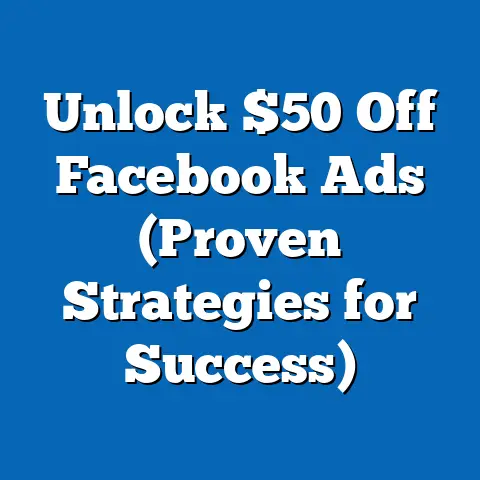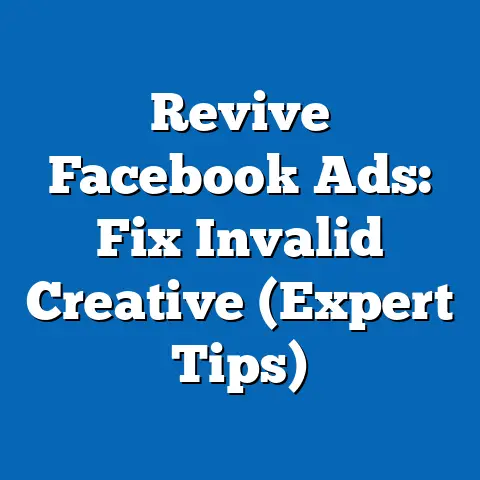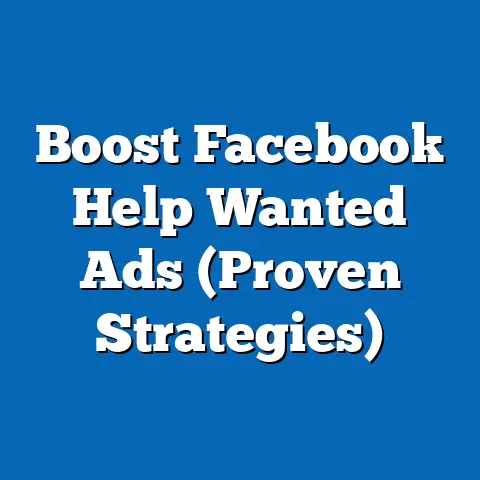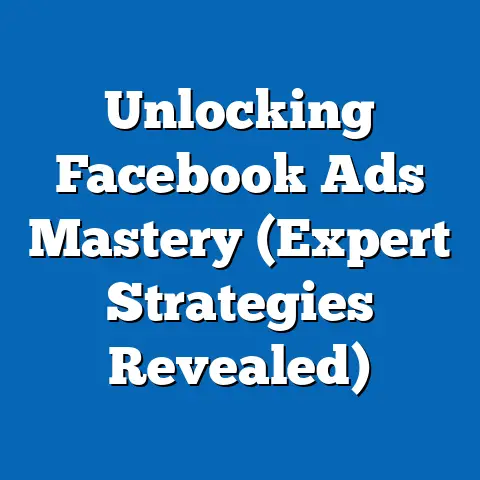Boost Sales with Top Diamond fb ad Strategies (Expert Insights)
Facebook advertising has become an essential tool for businesses of all sizes aiming to boost sales. What I find particularly compelling is how affordable it is compared to traditional marketing channels. In a world where even small businesses can compete in a crowded marketplace, understanding and implementing the right strategies is crucial. That’s where “Top Diamond FB Ad Strategies” come in – these are the techniques that can lead to significant returns on investment (ROI) when executed correctly. I’ve personally seen businesses transform their sales figures by simply refining their approach to Facebook ads, and I’m here to share those insights with you.
Understanding the Facebook Ad Landscape
The current state of Facebook advertising is nothing short of dynamic. With billions of active users, Facebook offers an unparalleled opportunity for businesses to reach a vast audience. But it’s not just about the numbers; it’s about engagement. Statistics show that users spend a significant amount of time on the platform daily, scrolling through their feeds and interacting with content. This high level of engagement makes Facebook an ideal place to capture attention and drive sales.
One of the first things I tell clients is to explore the diverse ad formats available. Facebook offers a range of options, including:
- Carousel Ads: Perfect for showcasing multiple products or features. I’ve seen these work wonders for e-commerce businesses.
- Video Ads: Ideal for grabbing attention and telling compelling stories. Short, engaging videos can significantly boost brand awareness.
- Slideshow Ads: A cost-effective way to create visually appealing ads using a series of images.
- Instant Experience Ads: Full-screen ads that load quickly and provide an immersive experience, great for mobile users.
- Lead Generation Ads: Designed to capture leads directly within Facebook, streamlining the process for potential customers.
Each ad format has its strengths and is relevant to different business goals. For instance, if you’re launching a new product line, carousel ads can highlight each item’s unique features. If you want to tell a brand story, video ads are your best bet.
What truly sets Facebook apart is its robust targeting options. You can target users based on:
- Demographics: Age, gender, location, education, and more.
- Interests: Hobbies, passions, and topics they engage with on Facebook.
- Behaviors: Purchase history, online activity, and device usage.
- Custom Audiences: Reach existing customers or leads based on their email addresses or phone numbers.
- Lookalike Audiences: Find new customers who share similar characteristics with your best customers.
These targeting options allow businesses to reach their ideal customers effectively, ensuring that your ads are seen by those most likely to convert. I’ve personally seen campaigns go from zero to hero simply by refining the targeting to align with the ideal customer profile.
Takeaway: Facebook advertising offers diverse ad formats and powerful targeting options, making it an ideal platform for businesses looking to boost sales. Understanding these features is the first step to creating effective campaigns.
Setting Up Your Facebook Ad Campaign for Success
Setting up a Facebook ad campaign can seem daunting, but with the right approach, it can be both affordable and effective. The key is to start with a clear strategy and focus on maximizing results without breaking the bank.
First and foremost, define your objectives. What do you want to achieve with your ad campaign? Common goals include:
- Brand Awareness: Increasing visibility and recognition of your brand.
- Lead Generation: Collecting contact information from potential customers.
- Conversions: Driving sales or other desired actions on your website.
- Website Traffic: Directing users to your website to explore your products or services.
- Engagement: Encouraging users to like, comment, and share your content.
Your objective will influence the type of ad you create, the audience you target, and the metrics you track. For example, if your goal is lead generation, you’ll want to use lead ads and focus on metrics like cost per lead (CPL). If your goal is conversions, you’ll want to track conversion rates and return on ad spend (ROAS).
Next, set a budget and bid strategy. Facebook offers several options, including:
- Daily Budget: The average amount you’re willing to spend each day.
- Lifetime Budget: The total amount you’re willing to spend over the entire campaign duration.
- Automatic Bidding: Facebook automatically sets your bids to get the most results for your budget.
- Manual Bidding: You set your bids manually, giving you more control over costs.
For those new to Facebook advertising, I recommend starting with a daily budget and automatic bidding. This allows you to test the waters and see how your ads perform without overspending. Once you have some data, you can switch to manual bidding to optimize your costs further.
Selecting the right audience is another critical step. Use Facebook’s targeting options to narrow down your audience based on demographics, interests, and behaviors. Don’t be afraid to experiment with different audiences to see what works best.
A/B testing is essential for refining ad performance without overspending. Create multiple versions of your ad with different headlines, images, and calls to action. Run these ads simultaneously and track their performance. The ads that perform best will give you valuable insights into what resonates with your audience.
Takeaway: Setting up a successful Facebook ad campaign involves defining clear objectives, setting a budget, selecting the right audience, and using A/B testing to optimize performance. By focusing on these elements, you can maximize your results without breaking the bank.
Crafting Compelling Ad Content
The content of your ad is what ultimately determines whether users will engage with it. Compelling ad copy and design are crucial for capturing attention and driving conversions.
Start with an engaging headline. Your headline is the first thing users will see, so it needs to grab their attention and make them want to learn more. Keep it short, clear, and benefit-driven. For example, instead of saying “New Product Launch,” try “Get 50% Off Our New Product!”
Your ad copy should be persuasive and highlight the benefits of your product or service. Focus on how it solves a problem or fulfills a need. Use clear, concise language and avoid jargon. Include a strong call to action (CTA) that tells users what you want them to do next. Examples include “Shop Now,” “Learn More,” “Sign Up,” and “Get a Quote.”
Visuals play a significant role in ad performance. High-quality images and videos can capture attention and convey your brand message effectively. Use visuals that are relevant to your target audience and that showcase your product or service in the best possible light.
Storytelling can be a powerful tool for connecting with audiences. Share stories that resonate with your target audience and that highlight the value of your product or service. For example, if you’re selling weight loss products, share a success story from a customer who has achieved their weight loss goals using your products.
Here are some additional tips for crafting compelling ad content:
- Use Emotional Appeal: Tap into the emotions of your target audience to create a connection.
- Highlight Social Proof: Show that others have had positive experiences with your product or service.
- Create Urgency: Use language that creates a sense of urgency and encourages users to take action now.
- Personalize Your Ads: Tailor your ads to the specific interests and needs of your target audience.
- Test Different Ad Formats: Experiment with different ad formats to see what works best for your business.
Takeaway: Compelling ad content is essential for capturing attention and driving conversions. Use engaging headlines, persuasive ad copy, high-quality visuals, and storytelling to connect with your audience and achieve your advertising goals.
Leveraging Retargeting and Custom Audiences
Retargeting and custom audiences are two of the most cost-effective strategies for boosting sales on Facebook. Retargeting allows you to reach users who have previously engaged with your brand, while custom audiences allow you to target specific groups of people based on their email addresses or phone numbers.
Retargeting works by placing a pixel on your website that tracks visitors. When someone visits your website, the pixel adds them to a retargeting audience. You can then create ads that are specifically targeted to this audience.
Retargeting is particularly effective for boosting sales because it allows you to reach users who are already familiar with your brand and who have shown interest in your products or services. These users are more likely to convert than cold audiences who have never heard of your brand before.
Custom audiences are created by uploading a list of email addresses or phone numbers to Facebook. Facebook then matches these contacts to users on its platform. You can use custom audiences to target existing customers, leads, or any other group of people you want to reach.
One of the most effective ways to use custom audiences is to create lookalike audiences. Lookalike audiences are created by identifying the characteristics of your best customers and then finding new users who share similar characteristics. This allows you to expand your reach while still maintaining a focus on affordability.
Here are some additional tips for leveraging retargeting and custom audiences:
- Segment Your Audiences: Create different retargeting and custom audiences based on their behavior and interests.
- Personalize Your Ads: Tailor your ads to the specific interests and needs of each audience.
- Use Dynamic Product Ads: Show users the exact products they viewed on your website.
- Exclude Existing Customers: Prevent existing customers from seeing ads for products they’ve already purchased.
- Test Different Ad Formats: Experiment with different ad formats to see what works best for each audience.
Takeaway: Retargeting and custom audiences are powerful tools for boosting sales on Facebook. By reaching users who are already familiar with your brand and tailoring your ads to their specific interests, you can increase your conversion rates and achieve your advertising goals.
Analyzing and Optimizing Ad Performance
Tracking ad performance is crucial for ensuring that your Facebook ad campaigns are effective and cost-efficient. Facebook Analytics and Ads Manager provide a wealth of data that you can use to monitor your campaigns and make informed decisions.
Key performance indicators (KPIs) to monitor include:
- Click-Through Rate (CTR): The percentage of users who click on your ad after seeing it.
- Conversion Rate: The percentage of users who take a desired action after clicking on your ad.
- Cost Per Acquisition (CPA): The cost of acquiring a new customer through your ad campaign.
- Return on Ad Spend (ROAS): The amount of revenue generated for every dollar spent on advertising.
- Reach: The number of unique users who saw your ad.
- Frequency: The average number of times each user saw your ad.
By tracking these KPIs, you can identify areas where your ad campaigns are performing well and areas where they need improvement. For example, if your CTR is low, it may indicate that your ad copy or visuals are not engaging enough. If your CPA is high, it may indicate that your targeting is too broad or that your landing page is not optimized for conversions.
Based on your performance data, you can take several steps to optimize your ads:
- Adjust Targeting: Refine your targeting to reach a more relevant audience.
- Refine Ad Copy: Experiment with different headlines, ad copy, and calls to action.
- Reallocate Budget: Shift your budget to high-performing ads and away from low-performing ads.
- Optimize Landing Pages: Ensure that your landing pages are optimized for conversions.
- Test Different Ad Formats: Experiment with different ad formats to see what works best for your business.
It’s important to continuously monitor your ad performance and make adjustments as needed. Facebook’s algorithm is constantly changing, so what worked well yesterday may not work as well today. By staying on top of your data and making informed decisions, you can ensure that your Facebook ad campaigns are always performing at their best.
Takeaway: Analyzing and optimizing ad performance is crucial for maximizing the effectiveness of your Facebook ad campaigns. By tracking key performance indicators and making data-driven decisions, you can improve your results and achieve your advertising goals.
Conclusion
Facebook advertising offers an affordable yet powerful tool for businesses looking to boost sales. By understanding the Facebook ad landscape, setting up your campaigns for success, crafting compelling ad content, leveraging retargeting and custom audiences, and analyzing and optimizing ad performance, you can achieve significant results without breaking the bank.
I encourage you to implement the expert strategies shared in this article to enhance your advertising efforts and achieve your sales goals. With the right approach, Facebook ads can be a game-changer for your business, driving growth and success in today’s competitive marketplace. Remember, the potential for growth and success is there – it’s all about leveraging the right strategies effectively.




